Dave Moore's Planetary Imaging Page
created by Mike Lockwood
This page is to provide space to show images captured by Dave Moore or
Phoenix,
AZ. Dave currently images with a 10" F/6.3 Newtonian and a 14.25"
F/20.8 classical
Cassegrain. A photo of the (very heavy) Cassegrain is included
below.
Unlike the other well-known planetary imagers, Dave doesn't have
steady
seeing due to ocean breezes. Instead, he must find those good
moments
amongst the hot, dry, often windy nights of Phoenix. Still, he
perseveres
and produces excellent images of planets, mainly through practice,
persistence, and hard work.
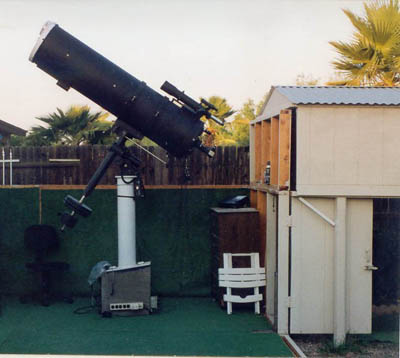
The original Cassegrain telescope was not performing as it should, and
Dave contacted me in the fall of 2005 after seeing
my writings about my 12.5" Cassegrain and our club's 16.25"
Cassegrain. Following
some long-distance debugging (on email and over the phone), I
received Dave's primary for testing and it
proved.... well... disappointing. The conic constant was not
close
to what it should be for either a classical Cassegrain or a
Dall-Kirkham.
At this point we decided that the best course of action to improve the
telescope's performance was to refigure
the primary to a parabola and make a new, smaller secondary (the old
one was 4.25" in diameter).
So, in early 2006 I refigured the primary mirror and made a new
3"
secondary for Dave's scope, and it became a 14.25" F/20.8 classical
Cassegrain
with a 3" diameter secondary. The obstruction is now only 21%,
compared to
the previous 30%.
Thus the reason I'm putting up this page for him - he's using my
optics! Also, he didn't have a good place to post images, and I
do.
With the uncoated secondary installed and after some more long-distance
collimation
advice, Dave phoned with the results: even uncoated he was seeing
detail
on Mars at higher powers than he could use before. The mirror got
aluminized,
and the new scope was complete. It featured improved primary
cooling, and a new focuser, spider, and secondary
holder. The last two items Dave fabricated himself. Also,
the baffling was
redone to suit the new optics.
A picture is worth a thousand words, so here are the before and
after
photos, taken under approximately the same seeing conditions. Dave
captured the first image of Jupiter (below) with the old Cassegrain in
2003. The image below that was obtained recently, including "Red
Spot Jr", and a transiting moon. What a difference!
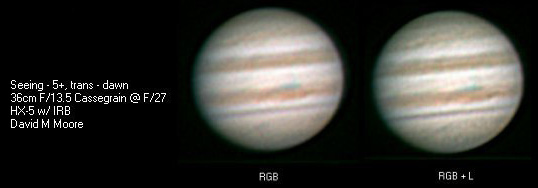 BEFORE.......
BEFORE.......
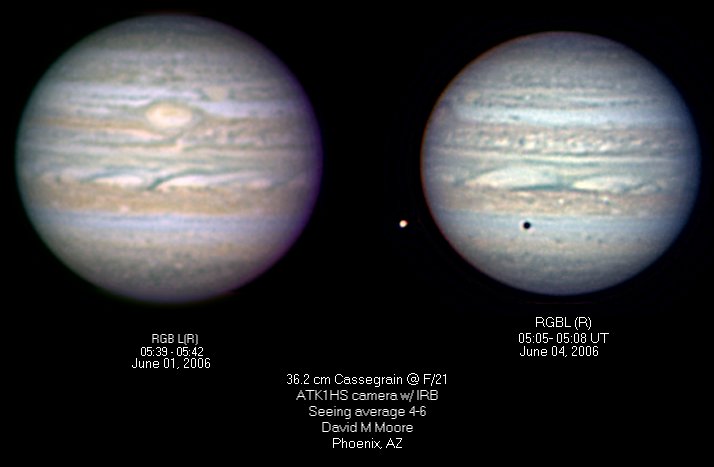
AFTER - Note "Red" and "Red Jr." rotating off the
disk at 10 o'clock position in the image at right.
I think the results speak for themselves. A bit better seeing and
there might be detail on the disk of that moon! Obviously the new
optics
have made a huge difference, but to be fair that is in combination with
improved
collimation, less central obstruction, an improved spider, new improved
baffling, and no barlow lens in the imaging train. Dave is not
one to heavily process images, so it's possible some more detail
could be teased from the second set of images if it were worked on more
aggressively or if different software were used.
Personally,
though, I enjoy seeing the subtle hues of the too-numerous-to-count
features
over the disk of mighty Jupiter. The subtle differences in the
pastel
hues of the bands, belts, storms, ovals, festoons and other features
are
quite beautiful, I think. In the future, I can't wait to post
more images here that show Dave's
hard work. I
am eager to see what a night of truly GOOD seeing will produce!
More Moore Images
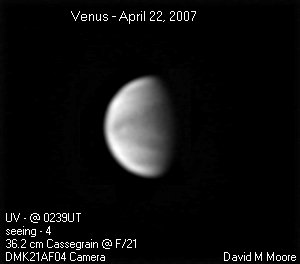
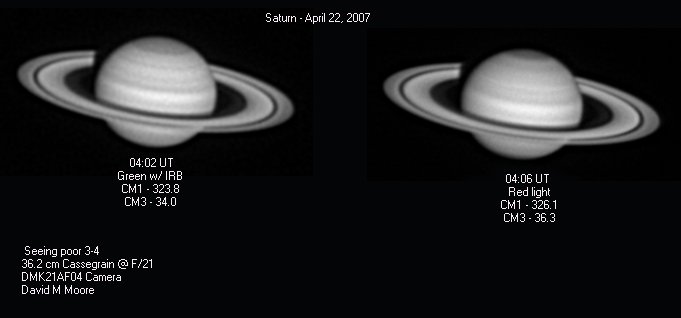

 BEFORE.......
BEFORE.......

